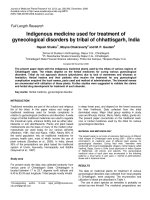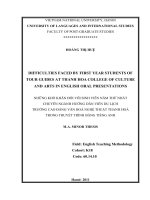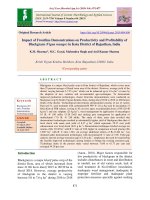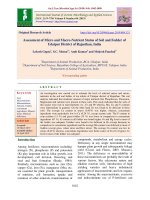Constraints faced by beneficiaries of ‘SABLA’ scheme of bikaner district of Rajasthan, India
Bạn đang xem bản rút gọn của tài liệu. Xem và tải ngay bản đầy đủ của tài liệu tại đây (442.26 KB, 9 trang )
Int.J.Curr.Microbiol.App.Sci (2019) 8(3): 2478-2483
International Journal of Current Microbiology and Applied Sciences
ISSN: 2319-7706 Volume 8 Number 03 (2019)
Journal homepage:
Original Research Article
/>
Constraints Faced by Beneficiaries of ‘SABLA’ Scheme
of Bikaner District of Rajasthan, India
Divya Rajpurohit*, Neena Sareen1, Nisha Meena2, Kanupriya Vyas3 and Jyoti Rajvi4
University of Agricultural and Horticultural Sciences, Shimoga-577204, Karnataka, India
*Corresponding author
ABSTRACT
Keywords
Adolescent girls,
SABLA scheme,
Health and nutrition
Article Info
Accepted:
24 February 2019
Available Online:
10 March 2019
Adolescence is a time of rapid physiological and psychological change of intensive
readjustment to the family, school, work and social life and of preparation for adult roles. The
term “adolescence” literally means “to emerge”, “to mature” or “achieve identity”. It is a
significant phase of transition from childhood to adulthood, which is marked by physical
changes accompanied by psychological changes. This is the time to make adolescents aware of
and informed about various facets of life in order to promote a healthy way of living.
Awareness of health, nutrition, lifestyle related behavior and adolescent reproductive & sexual
health (ARSH) needs to be positioned in this phase of life in order to improve the health of
adolescent girls and facilitate an easier transition to womanhood. During this period, nutritional
problems originating earlier in life as well as those occurring during the period itself can be
addressed. Going beyond this, AGs need to be viewed not just in terms of their needs but even
as individuals who would become productive members of society in future. Recognizing the
unmet needs of adolescent girls, Rajiv Gandhi Scheme for Empowerment of Adolescent Girls Sabla has been launched as a comprehensive intervention for adolescent girls in the age-group
of 11-18 years, with a focus on out of school girls. The objectives of the scheme are Nutrition
Provision, Iron Folic Acid (IFA) Supplementation, Health check-up and Referral Services,
Nutrition and Health Education, Guidance on Family Welfare, Adolescent Reproductive and
Sexual Health (ARSH), Child Care Practices and Home Management, Life Skills Education
and Accessing Public Services, Vocational Training (16-18 yrs). The present investigation was
under taken to know the Constraints of „SABLA‟ scheme as faced by beneficiaries and get a
clear picture of SABLA in Bikaner district so that the proper feedback could be given to the
concerned personnel, institutions and agencies to make it more effective and beneficial. This
study was conducted in six villages of Bikaner district of Rajasthan. Total sample size
comprised of 120 registered girls in Sabla Scheme by using proportionate random sampling.
Interview method was used for data collection. The results indicated that majority of
beneficiaries belonged to upper age group (15-18 years), from nuclear family (80.83%), with
monthly income of Rs. 6001 to 8000, belonged to general caste (35.83%), farming as family
occupation, primary passed with medium level of mass media exposure, having land above 2.15 hectare. Majority of these beneficiaries had high level of urban contact, with medium level of
extension contact and they had not participated in any training programme related to these
activities earlier. Non availability of variety in the supplementary nutrition, Long gap of 3
months of health check- ups, Duration of vocational training is short, Lack of practical oriented
knowledge on various aspects of nutrition and health and Lack of need based vocational
trainings were the major constraints of SABLA as perceived by beneficiaries.
2475
Int.J.Curr.Microbiol.App.Sci (2019) 8(3): 2478-2483
incidence of HIV, etc. require influencing the
health-seeking behavior of adolescent girls.
Introduction
Adolescence is a period of transition from
childhood to adulthood and is characterized by
efforts to achieve goals related to the
expectations of the mainstream culture, and by
spurts of physical, mental, emotional and
social
development
(WHO,
1986).
Adolescence is a crucial phase in the life of
woman when a girl stands at the threshold of
adulthood which is intermediary between
childhood and womanhood. It extends roughly
from 10-12 years of age till 19-20 for girls.
Adolescence in girls has been recognized as a
special period in their life cycle that requires
specific and special attention in terms of
nutritional, biological, and family life
(Academia.edu, 2015).
India has the largest population of adolescents
in the world by being home to 243 million
individuals aged 10-19 years, the country‟s
adolescents constituted 20 per cent of the
world‟s 1.2 billion adolescents (UNICEF,
2011).
Studies show that millions of adolescents
today do not enjoy access to quality education,
basic sexual and reproductive health care and
support for mental health issues and disability,
protection from violence, abuse and
exploitation, and forums for active
participation. Adolescent girls are a core
resource for national growth. Investment in
their health and development is investment in
the greater well-being of the country.
Considering that several of these girls are out
of school, get married early, face
discrimination in accessing health, education
and other services, work in vulnerable
situation, and are influenced by peer pressure,
they need special attention. The public health
challenges for adolescents, which include
pregnancy, risk of maternal and infant
mortality, sexually transmitted diseases,
reproductive tract infections, rapidly rising
As health and nutrition is important for the
adolescent girls but for overall development of
girls, life skills and vocational skills are also
required especially for rural girls. All
adolescent girls need life skills for their better
and holistic development.
They need to be looked at in terms of their
needs both as a group as well as individuals as
they are the future productive members of the
society. Recognizing the unmet needs of
adolescent girls, Rajiv Gandhi Scheme for
Empowerment of Adolescent Girls –
Sabla has been launched as a comprehensive
intervention for Adolescent girls in the agegroup of 11-18 years, with a focus on out of
school girls. Sabla, a Centrally-sponsored
scheme was approved by the Government on
16, Aug, 2010. To begin with, the Scheme was
implemented in 200 districts of the country on
a pilot basis and the scheme was started in
Bikaner in January 2011 with bhilwara and
dungarpur districts.
The present investigation was therefore under
taken to study the constraints of „SABLA‟ as
faced by beneficiaries.
Materials and Methods
The present study was conducted in Bikaner
district of Rajasthan. There are seven
Panchayat Samities in Bikaner District, out of
them; Bikaner Panchayat samiti was selected
purposely. In Bikaner panchayat samiti there
are 40 gram panchayats. Out of these, six
gram panchayats were selected randomly
namely, Napasar, Norangdesar, Palana,
Jaalwali, Jamsar, Kilchoo. One village from
each selected gram panchayat was selected
randomly. Thus six villages were selected for
present investigation (Napasar, Norangdesar,
Palana, Lakhusar, Jamsar, and Kilchoo). One
2476
Int.J.Curr.Microbiol.App.Sci (2019) 8(3): 2478-2483
hundred twenty adolescent girls from the age
group of 11-18 years who were registered
under SABLA scheme were selected from
these six villages by proportionate random
sampling technique.
The responses related to constraints of
SABLA were collected from beneficiaries on
three point continuum ranging viz., Very
Important, Important and Less important with
score 3, 2 and 1, respectively.
(89.17%) whereas only 10.83 per cent
participated in training programs as is visible
from table 1.
Constraints faced by the beneficiaries of
SABLA
The present investigation shows that extent of
constraints faced by the beneficiaries while
getting the services of „SABLA‟ Scheme. The
results have been presented in following
sectors:
Statistical analysis of data
Constraints related to
Appropriate statistical methods and tools like
frequency and percentage, Mean percent score
(MPS), standard deviation, Range and „t‟ Test
were used for the analysis of data.
Results and Discussion
Descriptive statistics of respondents
The results in table 1 reveal that nearly half of
the beneficiaries (51.67%) were in the Upper
age group (15-18 years) while 48.33 per cent
beneficiaries were in the lower age group (1115 years) with slightly more than half (55.00
%) of the beneficiaries having primary
education, followed by 43.33 per cent having
secondary education. It was encouraging to
note that none of the beneficiaries was
illiterate. The mass media exposure of
beneficiaries revealed that nearly two-third of
the beneficiaries had medium level of mass
media exposure (67.50%), followed by 18.33
per cent with high exposure and only 14.17
per cent were having low level of mass media
exposure. Further it is also revealed that
slightly more than half of the beneficiaries had
medium level of extension contact (61.67%)
followed by one-fourth who belonged to low
category and only 13.33 per cent respondents
having high level of extension contacts. It was
interesting to note that majority of the
beneficiaries had not participated in any
training program related to these activities
Constraints related to Nutrition provision
Constraints related to IFA supplementation
Constraints related to Health check-ups and
referral services
Constraints related to Guidance on family
welfare, reproductive health, nutrition and
health education
Constraints related to Life skills education and
Vocational training
The constraints have been ranked according to
their mean scores.
Constraints faced by beneficiaries related
to Nutrition provision
The data presented in table 2 showed that
constraint of “Non availability of variety in
the supplementary nutrition” was ranked first
by the beneficiaries with mean score 2.75. The
second most important constraint given by
SABLA beneficiaries was “Non availability of
Hot cooked meal” with 2.19 mean score. The
constraint of “Irregular supply of Take home
ration (THR) 15-18 yrs. Adolescent girls” was
ranked third with 1.17 mean score by the
beneficiaries.
Reason behind constraint of “Irregular supply
of Take home ration (THR) 15-18 yrs.
Adolescent girls” was due to long chain of
suppliers.
2477
Int.J.Curr.Microbiol.App.Sci (2019) 8(3): 2478-2483
The findings of Indian institute of
management Bangalore (2005) support the
present findings.
Constraints faced by beneficiaries related
to IFA Supplementation
The data presented in table 3 showed that
constraint of “Dislike the taste of IFA tablets”
was ranked first by beneficiaries with 2.83
mean score. The second important constraint
given by beneficiaries was “Lack of Provision
of 100 adult tablets of IFA” with mean score
1.00.
The present study finds supported from the
study conducted by Indian Institute of
Management Bangalore (2005).
Constraints faced by beneficiaries related
to Health Check-ups and Referral Services
The data presented in table 4 showed that
constraint of “Timings of regular school and
anganwadi center is same” was ranked first by
beneficiaries with mean score 3.00. The
second rank was given by SABLA
beneficiaries to the constraint of “Long gap of
3 months of health check- ups” with 2.65
mean scores. The constraint of “Lack of
transportation for health check-ups from
nearby town/city” was ranked third with 2.43
mean scores. This was followed by the
constraints of “Lack of getting feedback from
beneficiaries”, “Quality of free medicines is
not appropriate”, “Improper maintenance of
health record of adolescent girls” and
“Irregular visit of ANM/PHC staff at
Anganwadi” with mean scores of 2.37, 1.54,
1.27 and 1.22 respectively. These were ranked
as 4th, 5th, 6th, and 7th respectively.
The present investigation finds support from
the findings of Ministry of Women and Child
Development (2010) that also portray a similar
picture.
Constraints faced by beneficiaries related
to
Guidance
on
Family
Welfare,
Reproductive Health, Nutrition and Health
education
The data presented in table 5 showed that
constraint of “Lack of practical oriented
knowledge on various aspects of nutrition and
health” was ranked first by beneficiaries with
mean score 2.82. the second rank was given
by SABLA beneficiaries to the constraint of
“minimum use of audio visual aids for
supporting the education” with 2.75 mean
scores. The constraint of “Less coverage of
aspects regarding family welfare, family
planning and reproduction health” was ranked
third with 2.69 mean scores. This was
followed by the constraints of “Irregular
educative sessions for adolescent girls”,
“Irregular visit of experts for providing health
and nutrition education” and “Lack of
provision of skill in preparing locally available
nutritious recipes” with mean scores of 2.47,
2.17 and 2.16 respectively. These were ranked
as 4th, 5th and 6th respectively.
Constraints faced by beneficiaries related
to Life skills education and Vocational
training
The data presented in table 6 showed that
constraint of “Duration of vocational training
is short” was ranked first by beneficiaries with
mean score 2.71. The second rank was given
by SABLA beneficiaries to the constraint of
“Lack of need based vocational trainings”
with 2.7 mean scores. The constraint of “Lack
of awareness regarding communication skills,
confidence building” was ranked third with
2.57 mean scores. This was followed by the
constraints of “Lack of awareness regarding
rights and entitlement of adolescent girls”,
“Lack of trained personnel for giving
vocational trainings” and “Lack of visit public
services as post office, bank, PHC and CHC”
with mean scores of 2.55, 2.47 and 2.31
2478
Int.J.Curr.Microbiol.App.Sci (2019) 8(3): 2478-2483
respectively. These were ranked as 4th, 5th and
6th respectively. The findings of Formative
Research and Development Services, New
Delhi (2009) and Report of NRHM (2012)
supported the present findings.
Analysis of the overall view of Constraints
perceived by beneficiaries of SABLA
scheme
The data presented in 7 shows the extent of
constraints faced by the beneficiaries on the
basis of their rank as perceived by
beneficiaries while getting the services of
SABLA Scheme. Overall constraints were
classified according to highest to lowest by
ranking as perceived by SABLA beneficiaries
have been presented in table 6. The constraints
have been ranked according to their mean
scores. The data presented in table 7 shows
that constraint of “Life skills education and
vocational trainings” was ranked first by the
beneficiaries with mean score 2.58. The
second most important constraint given by
SABLA beneficiaries was “Guidance on
family welfare, reproductive health and
nutrition” with mean score 2.51. The
constraint of “Health check-up and referral
services” was ranked third with 2.07 mean
score by the beneficiaries. This was followed
by the constraint of “Nutrition provision” and
“IFA supplementation” with mean scores of
2.04 and 1.92 respectively. These were ranked
as 4th and 5th respectively. It may be concluded
from the findings that the Life skill education
and vocational trainings were least covered in
„SABLA‟ programme.
Table.1 Descriptive statistics of the beneficiaries
Categories
Frequency
(f)
Age group
Lower age group 11-15
Upper age group 15-18
Educational level
Illiterate
Literate
Primary level
Secondary level
Mass media exposure
Low (below 8)
Medium (8-16)
High (above 16)
Extension contact
Low (below 21)
Medium (22-25)
High (above 25)
Training
Yes
No
2479
n = 120
Percentage
(%)
58
48.33
62
51.67
0
2
66
52
0.00
1.67
55.00
43.33
17
81
22
14.17
67.50
18.33
30
74
16
25.00
61.67
13.33
13
107
10.83
89.17
Int.J.Curr.Microbiol.App.Sci (2019) 8(3): 2478-2483
Table.2 Extent of constraints faced by beneficiaries related to nutrition provision
S. No.
1
(i)
(ii)
(iii)
Constraints
Nutrition provision
Non availability of variety in the
supplementary nutrition
Non availability of Hot cooked meal
Irregular supply of Take home ration
(THR) 15-18 yrs. Adolescent girls
Extent of intensity
Very
Important
Less
important
(2)
important
(3)
(1)
f
f
f
n = 120
MS Rank
90
30
0
2.75
1
45
0
53
20
22
100
2.19
1.17
2
3
f = frequency, MS = Mean Score
S.
No.
2
(i)
(ii)
Table.3 Extent of constraints faced by beneficiaries related to IFA supplementation
n = 120
Constraints
Extent of intensity
MS
Rank
Very
Important
Less
important
(2)
important
(3)
(1)
F
f
f
IFA Supplementation
Dislike the taste of IFA tablets
100
20
0
2.83
1
Lack of Provision of 100 adult
0
0
120
1.00
2
tablets of IFA
f = frequency, MS = Mean Scores
Table.4 Extent of constraints faced by beneficiaries related to health check-ups and referral
services
n = 120
S.
No.
3
Constraints
Extent of intensity
Very important (3)
MS
Important (2)
Less important (1)
f
f
f
Rank
Health Check-ups and Referral Services
(i)
(ii)
long Gap of 3 months of health check- ups
Timings of regular school and Anganwadi center is same
87
120
24
0
9
0
2.65
3.00
2
1
(iii)
82
8
30
2.43
3
(iv)
(v)
Lack of transportation for health check-ups from nearby
town/city
Improper maintenance of health record of adolescent girls
Irregular visit of ANM/PHC staff at Anganwadi
0
4
33
19
87
97
1.27
1.22
6
7
(vi)
Quality of free medicines is not appropriate
19
27
74
1.54
5
(vii)
Lack of getting feedback from beneficiaries
57
51
12
2.37
4
f = frequency, MS = Mean Scores
2480
Int.J.Curr.Microbiol.App.Sci (2019) 8(3): 2478-2483
Table.5 Extent of Constraints faced by beneficiaries related to Guidance on Family Welfare,
Reproductive Health, Nutrition and Health Education
n = 120
S.
No.
4
Constraints
Extent of intensity
Very important
(3)
f
Important (2)
f
MS
Rank
Less important
(1)
f
Guidance on family welfare, reproductive health, nutrition and health education
(i)
Irregular educative sessions for
adolescent girls
84
9
27
2.47
4
(ii)
Lack of practical oriented knowledge
on various aspects of nutrition and
health
Lack of provision of skill in preparing
nutritious recipes from locally
available food stuffs
Irregular visit of experts for providing
health and nutrition education
minimum use of audio visual aids for
supporting the education
98
22
0
2.82
1
51
37
32
2.16
6
20
100
0
2.17
5
80
29
11
2.75
2
Less coverage of aspects regarding
family welfare, family planning and
reproductive health
92
19
9
2.69
3
(iii)
(iv)
(v)
(vi)
Table.6 Extent of constraints faced by beneficiaries related to Life Skills Education and
Vocational Training
n = 120
S.
Constraints
Extent of intensity
MS
No.
Very
Important
Less
important
(2)
important
(3)
(1)
f
f
f
5
Life skills education and Vocational training
89
9
27
2.47
(i) Lack of trained personnel for giving
vocational trainings
79
28
13
2.55
(ii) Lack of provision of awareness
regarding rights and entitlement of
adolescent girls
91
22
7
2.7
(iii) Lack of need based vocational trainings
87
14
19
2.57
(iv) Lack of provision of awareness
regarding communication skills,
confidence building
94
17
9
2.71
(v) Duration of vocational training is short
53
51
16
2.31
(vi) Lack of visit public services as post
office, bank, PHC and CHC.
f = frequency, MS = Mean Scores
2481
Rank
5
4
2
3
1
6
Int.J.Curr.Microbiol.App.Sci (2019) 8(3): 2478-2483
Table.7 Analysis of the overall view of constraints faced by beneficiaries of SABLA
S.
No.
1
2
3
Constraints
Constraints related to Life skills education and Vocational training
Nutrition provision
Constraints related to Life skills education and Vocational training
IFA supplementation
Constraints related to Life skills education and Vocational training
Health check-up and referral services
Mean
Score
2.04
Rank
1.92
5
2.07
3
4
4
Constraints related to Life skills education and Vocational training
Guidance on family welfare, reproductive health and nutrition
2.51
2
5
Life skills education and vocational trainings
2.58
1
Constraints faced by beneficiaries of
‘SABLA’ and other programmes for
adolescent girls
The major findings of the present study
revealed that in general information majority
of beneficiaries belonged to upper age group,
from the nuclear family, up to 5 members,
monthly income Rs. 6001 to 8000, belonged
to general Caste, families were doing farming,
passed primary level, medium level of mass
media exposure, had above 2.1-5 hectare land,
high level of urban contact, had medium level
of extension contact and had not participated
in any training programme related to the
activities.
Beneficiaries faced some constraints like Non
availability of variety in the supplementary
nutrition, Long gap of 3 months of health
check- ups, Duration of vocational training is
short, Lack of practical oriented knowledge
on various aspects of nutrition and health and
Lack of need based vocational trainings etc.
In conclusion, SABLA scheme for adolescent
girls is a unique programme that endeavours
to have adolescent girls with enhanced self
esteem, improved nutrition and health status
with enhanced skills and the capacity to make
informed
choices,
through
various
components included in it. Sabla, the
government is investing in the health,
nutrition and development needs of
adolescent girls to advance their rights to
education, health and protection which will
help them to build a future of gender equality
and justice. All this, will in turn help in
building of a self-reliant and confident
women citizenry. The present investigation
conclude that majority of the beneficiaries
were getting the benefit of the scheme and
perceived it as an important initiative.
Beneficiaries faced some constraints like Non
availability of variety in the supplementary
nutrition, Long gap of 3 months of health
check- ups, Duration of vocational training is
short, Lack of practical oriented knowledge
on various aspects of nutrition and health and
Lack of need based vocational trainings etc.
The
present
investigation
felt
that
incorporation of the suggestions related to
nutrition provision i.e. majority (93.33%) of
beneficiaries suggested that “variety should
be added in supplementary nutrition for
adolescent girls”. The suggestions related to
health checkups and referral services i.e.
majority (96.67%) of the beneficiaries
suggested that “quality of free medicines
should be good.” The suggestions related to
2482
Int.J.Curr.Microbiol.App.Sci (2019) 8(3): 2478-2483
guidance on family welfare, reproductive
health, nutrition and health education i.e.
majority (85.00%) suggested that “proper
transport facilities should be provided in
village”. The suggestion related to life skills
education and vocational training i.e. majority
(97.50%) of beneficiaries were suggested that
“vocational training should be organized
according to available time by the adolescent
girls” so it would further enhance the quality
of this scheme. It is recommended that similar
study can be conducted in other district along
with a large number of samples. A
comparative study can be done on the topic
“performance of SABLA scheme in rural and
urban areas”. Awareness programme could be
planned on the functions of SABLA scheme.
References
Administrative Staff College of India (2013).
“Evaluation of SABLA Scheme” A
Report Submitted to Ministry of
Women and Child Development.
Government of India. Hyderabad,
September.
Available
at
/>Anonymous (2002). “Evaluation study on AG
scheme implementation in Kerala,
Shodh
Ganga”.
Available
at
www.shodhganga.com
Formative Research and Development
Services (2010). “Adolescent Girl‟s
Scheme in UP and Rajasthan”. Kishori
Shakti Yojana (KSY) under the ambit of
ICDS in Uttar Pradesh and Rajasthan‟;
Executive Summary, Ministry of
Women and Child Development,
Government of India, New Delhi
Malhothra,
(2010).
“Process-outcome
evaluation study on the KSY
implementation done in North India in
year the 1999-2002”. available at
/>Rajiv Gandhi scheme for empowerment of
adolescent girls (RGSEAG) –Sabla,
(2010). “Implementation guidelines,
Dec, Ministry of women and child
development”. Government of India,
New
Delhi,
available
at
/>WHO (1986). “Young people‟s health: a
challenge for society” A Report of a
WHO study group on young people and
“health for all by the year 2000”.World
health
organization,
Geneva,
Switzerland. World health organization
technical report series 731. Available at
/>41720/1/WHO_TRS_731.pdf
How to cite this article:
Divya Rajpurohit, Neena Sareen, Nisha Meena, Kanupriya Vyas and Jyoti Rajvi. 2019.
Constraints Faced by Beneficiaries of „SABLA‟ Scheme of Bikaner District of Rajasthan,
India. Int.J.Curr.Microbiol.App.Sci. 8(03): 2478-2483.
doi: />
2483









